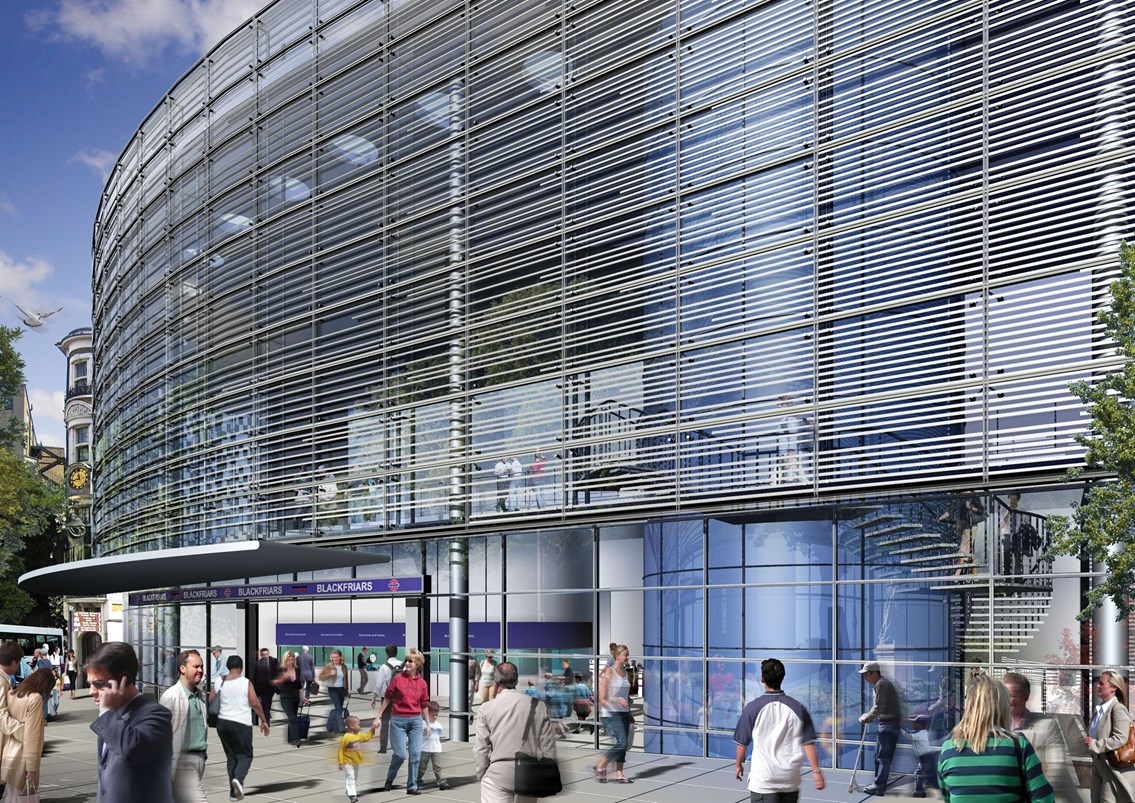Thursday 24 Sep 2009
NEW DESTINATION FOR HISTORIC BLACKFRIARS 'DESTINATION WALL'
- Region & Route:
- | Southern
An important and unique part of British rail history is set for a facelift and a new home, as part of Network Rail’s £350m redevelopment of Blackfriars rail station.
The destination wall, specially designated for protection by the Railway Heritage Committee in April this year, will be carefully removed stone by stone from its current location in the upper concourse of the station, left of the ticketing gates.
The wall, part of the original façade of the 1886 Blackfriars station (originally known as St Paul’s), features the names of 54 destinations - each painstakingly carved into separate sandstone blocks. These blocks vary in size and weight, with the lightest weighing around 45 kilograms and the heaviest up to 120 kilograms. A large number of these stones bear the names of the business capitals of Europe, highlighting the importance of the railway and Blackfriars as a main departure point from London over 120 years ago.
It will be restored to its former glory by Rupert Harris Restoration, who are also currently carrying out restoration work on two other historic features of the Blackfriars station area for Network Rail, the Temperance Fountain and the statue of Queen Victoria.
It is expected that the meticulous restoration work on the destination wall will take up to 1,900 hours and will involve working from the top down, carefully chiselling mortar joints between each stone, numbering each piece, then lifting them down and packing them in specially designed crates. Following this the lettering of each stone will be gilded in 24 carat gold leaf using the oil gilding technique before the wall is re-built in its new location.
Jerry Swift, Network Rail’s head of corporate responsibility, comments: “The destination wall is a fascinating and treasured piece of rail history, and we are committed to preserving it.
“Incorporating the wall into the design of the new station is also highly symbolic, given that a number of new destinations will become directly accessible from Blackfriars station when this landmark project is completed ahead of the 2012 Olympic Games."
Jim Morgan, managing director of train operator First Capital Connect which operates Blackfriars station, said: “The reconstruction of Blackfriars looks to the future by giving it platforms and facilities for crowd-busting, longer 12-carriage trains. It’s great that Network Rail is keeping an eye to the past too by preserving such a fascinating piece of its heritage.”
Christopher Fildes, Railway Heritage Committee, comments: “In 1886 the London Chatham & Dover Railway pushed northwards across the Thames to a new terminus which it called St Paul's, which was later renamed Blackfriars. This gave the railway a foothold in the City of London. On the facade were engraved 54 destinations in Britain and Europe which could be reached from the new station. The most remote was St Petersburg. They reflected the City's pre-eminence as the centre of international finance.
“When the station was rebuilt in the 1970s, the engraved destinations were saved and arranged as a 'wall of names' in the new concourse. A second rebuilding is now under way, and the names will also be preserved, as befits their significance in the history of the City and its railways. We have met with representatives from Network Rail to discuss the destination wall and are pleased with their plans. We look forward to seeing the end result.”
ENDS
Notes to editors:
About the Blackfriars Destination Wall
Date: 1886
Architect: J Wolfe Barry working with Henri Marc Brunel, son of Isambard, and W Mills, engineer of the London Chatham & Dover Railway
Featured cities: ANTWERP, ASHFORD, GRAVESEND, DARNSTADT, BALE, BADEN-BADEN BECKENHAM, HERNE BAY, FLORENCE, NICE, BERLIN, BICKLEY, MAIDSTONE, FRANKFORT, GENOA, BOULOGNE, BROADSTAIRS, MARGATE, GENEVA, PARIS, BREMEN, BROMLEY, RAMSGATE, LAUSANNE, MILAN, BRINDISI, CANTERBURY, ROCHESTER, LEIPSIC ROME, BRUSSELS, CHATHAM, SEVENOAKS, LUCERNE, LYONS, CALAIS, CRYSTAL PALACE, SITTINGBOURNE, MARSEILLES, TURIN, CANNES, DEAL, SHEERNESS, VIENNA, NAPLES, COLOGNE, DOVER, WESTGATE-ON-SEA, ST PETERSBURG, VENICE, DRESDEN, FAVERSHAM, WALMER AND WIESBADEN.
About the Blackfriars station re-development
- The existing station on the north bank will be completely redeveloped to create a spacious and airy entrance and concourse area incorporating improved interchange facilities with Tube services. The London Underground station will also be significantly enhanced.
- By the end of 2011, the station will be able to handle longer 12 car trains for the first time with significantly more trains stopping at the station every hour.
- The station will provide the first direct National Rail access to the South Bank in over a century, providing direct access to many attractions including the Tate Modern and the surrounding area.
Notes to editors
Contact information
Passengers / community members
Network Rail national helpline
03457 11 41 41
Latest travel advice
Please visit National Rail Enquiries
Journalists
Network Rail press office - South East route
020 3357 7969
southeastroutecomms@networkrail.co.uk
About Network Rail
We own, operate and develop Britain's railway infrastructure; that's 20,000 miles of track, 30,000 bridges, tunnels and viaducts and the thousands of signals, level crossings and stations. We run 20 of the UK's largest stations while all the others, over 2,500, are run by the country's train operating companies.
Usually, there are almost five million journeys made in the UK and over 600 freight trains run on the network. People depend on Britain's railway for their daily commute, to visit friends and loved ones and to get them home safe every day. Our role is to deliver a safe and reliable railway, so we carefully manage and deliver thousands of projects every year that form part of the multi-billion pound Railway Upgrade Plan, to grow and expand the nation's railway network to respond to the tremendous growth and demand the railway has experienced - a doubling of passenger journeys over the past 20 years.
Follow us on Twitter: @networkrail
Visit our online newsroom: www.networkrailmediacentre.co.uk

